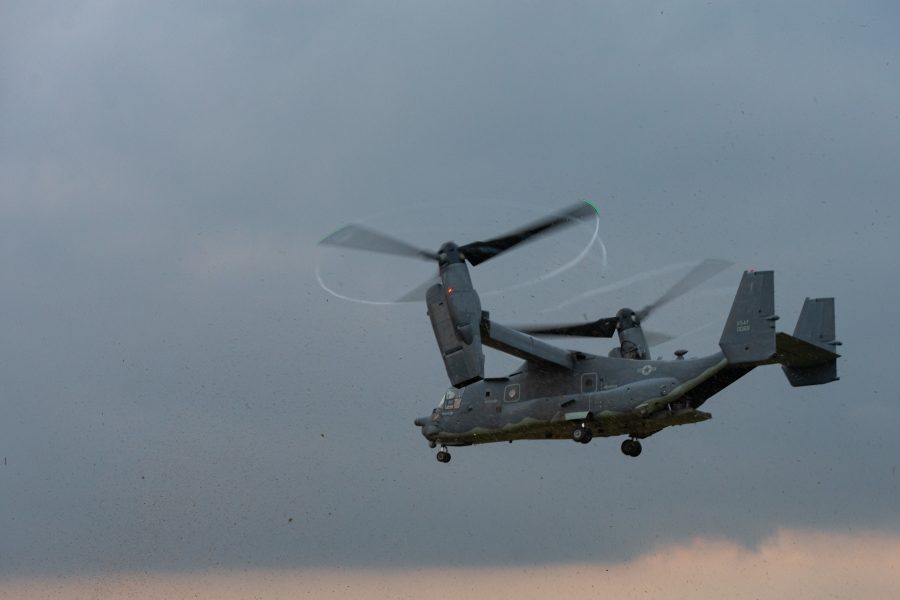Editor’s Note: This article was updated on Dec. 1 and Dec. 3 with additional details.
Air Force Special Operations Command has recovered and identified the remains of one Airman from the U.S. Air Force CV-22 Osprey that crashed off the coast of southern Japan last week, while seven others remain missing as U.S. and Japanese officials continue their search.
Staff Sgt. Jacob “Jake” M. Galliher, 24, was a native of Pittsfield, Mass., according to AFSOC. He enlisted in the Air Force in 2017 and served as a Direct Support Operator—DSO—working as an airborne linguist specializing in Mandarin. A member of the 43rd Intelligence Squadron, Detachment 1, Operating Location—Alpha, Galliher earned the Air Force Achievement Medal, Air and Space Commendation Medal, Air Force Outstanding Unit Award, and Air Force Meritorious Unit Award in his career.
The seven other members of the CV-22 crew remain unidentified and are in DUSTWUN status—“duty status-whereabouts unknown.”
“We’re very proud of them—all of them—and we’re very saddened by that situation,” Air Force Chief of Staff Gen. David W. Allvin said Dec. 2 at the Reagan National Defense Forum.
AFSOC confirmed the death of one Airman on Dec. 1 and identified Galliher on Dec. 3.
The Pentagon and the Japanese Ministry of Defense have both said the ocean search continues.
“Emergency personnel remain on scene conducting search and rescue operations,” Deputy Pentagon Press Secretary Sabrina Singh told reporters Nov. 30.
The aircraft was assigned to 353rd Special Operations Wing and based at Yokota Air Base, Japan. It went down during what Air Force and Pentagon officials have called a “routine training mission” near Yakushima, Japan. The unit operating the CV-22 involved in the mishap is not currently conducting flight operations, Singh added in Dec. 1 statement.
In remarks before the fatality was confirmed, Singh added that “our efforts are on, of course, thinking of these families who are missing their loved ones right now.”
In a statement on Nov. 29, the Japanese Ministry of Defense said the aircraft crashed at roughly 2:50 p.m. local time, and Japanese military and coast guard dispatched aircraft and ships to conduct a search and rescue operation. Singh said the U.S. military is now leading the effort with Japanese assistance.
“The U.S. military, alongside the Japan Coast Guard, Japanese Self-Defense Forces, local law enforcement, and Japanese civilian volunteers, is continuing search and rescue operations for the CV-22 crew,” AFSOC said in its Dec. 1 statement. “Search and rescue operations consist of a combination of air, surface, and subsurface search of water and coastline in the vicinity of Yakushima, Japan, in order to locate the crewmembers.”
Pacific Air Forces; United States Pacific Fleet; United States Marine Corps Forces, Pacific; Special Operations Command Pacific; 353rd Special Operations Wing, Kadena Air Base, Japan; 18th Wing, Kadena Air Base, Japan; and the 1st Special Forces Group are involved in the search efforts, the U.S. military said.
“Our sincere gratitude to all the units and Japanese partners involved in helping us locate our Airmen,” AFSOC said in a statement.
The Osprey, which is also used by the Marine Corps and Navy, is a tilt-rotor aircraft, which allows it to take off and land like a helicopter, then move its rotors and fly like an airplane. Air Force Special Operations Command operates a fleet of around 50 Ospreys.
Across the military, there has been no decision to ground the aircraft, Singh said Nov. 30, even as the Japanese reportedly decided to ground their fleet of Ospreys.
The next day, Singh noted in a statement that all U.S. V-22 Ospreys in Japan “operate only after undergoing thorough maintenance and safety checks. We have already started sharing information about the accident with our Japanese partners, and have pledged to continue to do so in a timely and transparent manner. “
The Osprey has developed a poor safety reputation among the public. In August, three Marines were killed when their Osprey crashed in Australia. In 2022, two separate crashes in San Diego and Norway resulted in the deaths of nine Marines. An Air Force has had one previous fatal mishap involving a CV-22, which occurred in 2010.
AFSOC temporarily grounded the Osprey in 2022 after two “hard clutch engagements,” in which the clutch slips and reengages. However, the cause of the latest incident is unknown, according to military officials.
For now, military officials said the focus remains on finding the Airmen and wreckage or the Osprey.
“There is an investigation that is currently determining and looking into what exactly happened with this aircraft and the mishap,” Singh said. “Should that investigation yield in results that require the department to change anything about the Osprey or to take additional steps, we will certainly do that.”
“We are taking what happened, the mishap of one of our aircraft, extremely seriously,” she added. “There’s a true commitment to safety when it comes to any of our Airmen operating any aircraft.”
